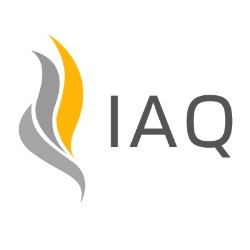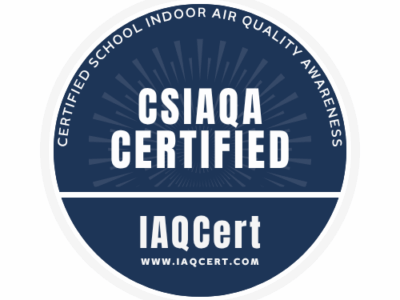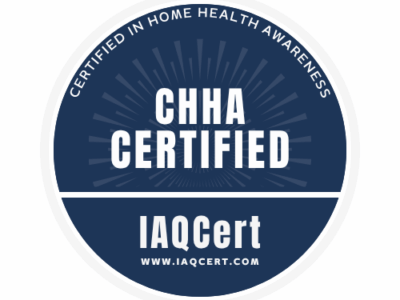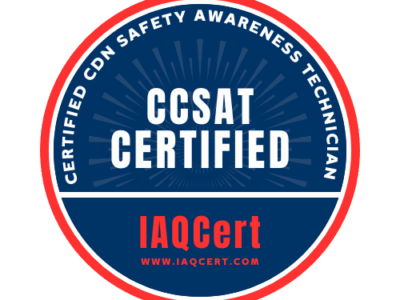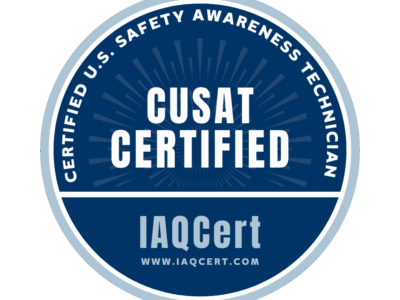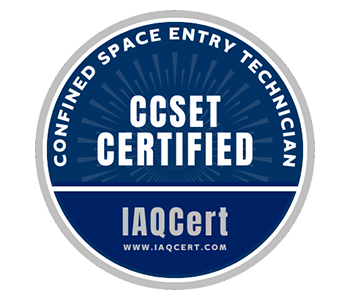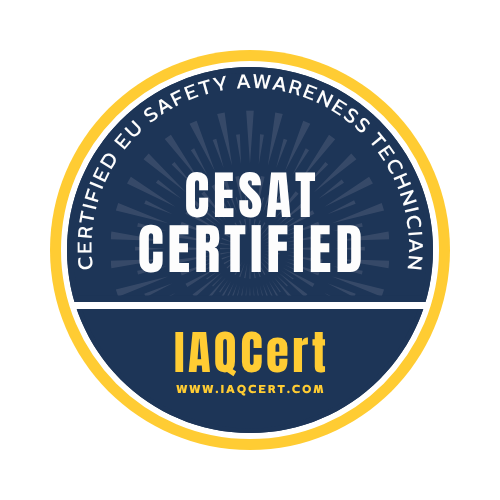Certified European Safety Awareness Technician (CESAT)
The Certified European Safety Awareness Technician (CESAT) course provides in-depth training on identifying, assessing, and controlling workplace hazards across European job sites. The program is based on EU-wide regulations such as Directive 89/391/EEC, supported by EN safety standards and national enforcement structures. Core topics include hazard assessment, PPE selection, chemical safety under REACH/CLP, and machinery safeguarding.
Participants gain practical knowledge of EU-OSHA frameworks, understand how safety laws are implemented across member states, and learn how to promote prevention and compliance in industrial, construction, and logistics environments.
Overview
Certification
As a CESAT-certified technician, you’ll bring recognized safety credibility to any European job site.
This Assessment-Based Certificate (ABC) program validates your proven understanding of EU safety regulations and best practices, enhancing your value to employers, agencies, and inspection bodies. After passing the exam, you can proudly display your digital IAQCert badge on resumes, tenders, site documentation, and professional networks to demonstrate verified safety expertise and real-time credential authenticity.
Learning Approach
1. LearnEase
Ideal for safety coordinators, supervisors, or newcomers seeking structured learning. Access 48 detailed lessons across 12 modules, reinforced with 5 progressive quizzes. Study at your own pace with full reference access for future fieldwork. Start Learning Now!
2. CertFast
For experienced professionals. Skip the full course and go straight to a timed 1-hour certification exam to validate your skills and earn the CESAT badge. Get Certified Fast!
Learning Outcomes
- Explain the mission of EU-OSHA and the legal structure of occupational health and safety in Europe under Directive 89/391/EEC.
- Identify and assess physical, chemical, biological, ergonomic, and psychosocial hazards using risk assessment methods aligned with EU prevention principles.
- Interpret REACH and CLP regulations for chemical safety, including GHS pictograms, labeling, and Safety Data Sheets (SDS).
- Select and maintain CE-marked PPE according to PPE Regulation (EU) 2016/425 and EN safety standards for respiratory, hand, and eye protection.
- Apply lockout/tagout practices, machine safeguarding methods, and comply with the Machinery Directive 2006/42/EC.
- Follow safe practices for forklift operation, pedestrian separation, and material handling under EN ISO 3691.
- Recognize and respond to environmental stressors such as heat, noise, dust, and UV exposure, following EU exposure limit guidance.
- Develop a compliant emergency action plan with evacuation routes, fire extinguisher protocols, and incident reporting, aligned with EU directives and signage standards.
- Implement ergonomic improvements for lifting and screen use, in line with Directives 90/269/EEC and 90/270/EEC.
- Promote psychosocial risk prevention through awareness of workplace stress, harassment, and violence, reflecting EU-level guidance and dignity-at-work principles.
Whether you follow the full curriculum (LearnEase) or validate your knowledge with the fast-track exam (CertFast), CESAT gives you the professional credibility, practical skills, and safety mindset to operate confidently in any European work environment—from logistics and construction to manufacturing and technical trades.
Enrollment & Certification Policy
Your enrollment includes full access to all 12 CESAT modules and 5 exams for a period of three years from the original date of enrollment. Certification is granted immediately upon passing the final exam, and remains valid for three years from that date.
Curriculum
Curriculum
- 13 Sections
- 48 Lessons
- 156 Weeks of Access
- Module 1.0 – Introduction to EU-OSHA & Worker Safety Rights in the EUThis module sets the foundation for European safety awareness by introducing EU-OSHA, the core regulatory body for occupational health and safety in the EU. Learners will explore the Framework Directive 89/391/EEC, understand how safety laws are structured, and learn the distinct rights and responsibilities of both workers and employers under EU law. National-level enforcement structures and the role of labor inspectorates are also introduced.4
- Module 2.0 – Hazard Identification & Risk AssessmentLearn how to identify workplace hazards and assess risks using tools and principles recognized across the EU. This module explores key hazard types — physical, chemical, biological, ergonomic, and environmental — and teaches the widely adopted 5-step risk assessment method. It also covers the Nine Principles of Prevention, which serve as the foundation for all EU workplace safety controls.4
- Module 3.0 – Workplace Layouts, Surfaces & Fall PreventionThis module focuses on safe physical environments. Learners will explore European EN standards for walking-working surfaces, ladders, scaffolding, and elevated work platforms. Emphasis is placed on eliminating slip, trip, and fall hazards — a leading cause of workplace injury — through proper planning, guardrails, signage, and best practices.4
- Module 4.0 – Chemical Safety & Hazard Communication (REACH & CLP)Understand how the EU regulates chemical hazards through the REACH and CLP frameworks. Learners will explore Safety Data Sheets, GHS-aligned pictograms, proper labeling, and chemical storage standards. The module emphasizes workers' right to understand chemical risks and take action in accordance with EU law.4
- Module 5.0 – Personal Protective Equipment (PPE) in the EUThis module covers the proper selection, use, and maintenance of PPE in compliance with EU Regulation 2016/425. Learners will understand how CE-marked equipment is classified under EN standards and how employers are obligated to assess risks, provide training, and maintain documentation. The limitations and proper fit of PPE are also addressed.4
- Module 6.0 – Respiratory Protection & Air Quality AwarenessAirborne hazards — including dust, smoke, and fumes — require targeted controls. This module introduces European respirator classifications (e.g., FFP2/FFP3 under EN 149), ventilation strategies, and the importance of fit testing. Learners will also explore medical fitness considerations and how to maintain respiratory protection equipment in compliance with EU best practices.4
- Module 7.0 – Lockout/Tagout & Machinery Safety (Directive 2006/42/EC)Covering the Machinery Directive 2006/42/EC, this module outlines the safe handling of mechanical equipment and the control of hazardous energy. Learners will explore lockout/tagout procedures, emergency stops, guarding of moving parts, and the importance of clear operating procedures to reduce injury risks.4
- Module 8.0 – Vehicle, Forklift & Material Handling SafetyForklift safety and material handling are essential for logistics, warehousing, and industrial operations. This module examines European safety expectations under EN ISO 3691, including load stability, aisle spacing, pedestrian protection, and battery safety. Operator training and daily inspection routines are emphasized.4
- Module 9.0 – Environmental & Occupational Health ExposuresExplore how environmental factors affect workplace safety. This module addresses heat and cold stress, wildfire smoke, dust particles, noise exposure (Directive 2003/10/EC), and UV radiation risks. Prevention strategies, protective protocols, and occupational exposure limits are reviewed in a European regulatory context.4
- Module 10.0 – Emergency Preparedness & Evacuation StandardsThis module prepares learners to recognize and respond to workplace emergencies. It covers EU-mandated emergency action planning, evacuation routes and signage (EN ISO 7010), fire extinguisher use, alarm systems, and incident reporting. Emphasis is placed on proactive readiness and response accountability.4
- Module 11.0 – Ergonomics & Musculoskeletal HealthPreventing repetitive strain and overexertion injuries is key in every EU workplace. Learners will study ergonomic risk factors, safe lifting techniques, workstation layout, and preventive administrative controls. Directives related to manual handling (90/269/EEC) and display screen use (90/270/EEC) are included.4
- Module 12.0 – Psychosocial Risk, Harassment & Workplace ViolencePsychological safety is a growing priority across the EU. This final module addresses stress management, bullying, harassment, and workplace violence prevention. Learners will review EU-level guidance and strategies for creating respectful, inclusive, and mentally healthy work environments.4
- CESAT Certification Exam5

